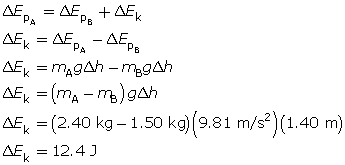Module 6—Work and Energy
 Lesson 3 Lab: Work-Energy Theorem Lab
Lesson 3 Lab: Work-Energy Theorem Lab
Problem
Is the work-potential energy theorem applicable when a non-conservative resistance force, such as friction, is present?
Procedure
Re-open the Work-Energy Theorem simulation, if necessary. Complete the following steps:
- Reset the simulation and close the graph window.
- Turn on the non-conservative friction force by selecting the “Resistance” (
 ) option.
) option.
- Create a path by clicking on the reference point and dragging the object upwards.
- Use the graphing techniques that you used in the Work-Potential Energy Lab to measure the work done, the change in potential energy, and the total length of the path (distance). Note: You have to delete any old graphs before making new ones. To do this, use the “Add” and “Subtract” buttons on the grapher (
 ).
).
 Module 6: Lesson 3 Assignment
Module 6: Lesson 3 Assignment
Remember to submit the answers to LAB 7, LAB 8, LAB 9, and LAB 10 to your teacher as part of your Module 6: Lesson 3 Assignment.
Observations
LAB 7. In the following table, summarize your findings for three different paths that end at approximately the same spot.
| Path | Change in Height (m) | Work Done (J) | Change in Potential Energy (J) | Length of Path (m) |
| 1 | ||||
| 2 | ||||
| 3 |
Analysis
LAB 8. Based on your data above, does path independence hold when there are non-conservative resistance forces present?
LAB 9. How does the work done compare with the change in potential energy when non-conservative forces are present?
LAB 10. Is the work-potential energy theorem applicable when there are resistive or non-conservative forces present?
 Module 6: Lesson 3 Assignment
Module 6: Lesson 3 Assignment
Remember to submit the answer to LAB 11 to your teacher as part of your Module 6: Lesson 3 Assignment.
Conclusion
LAB 11. Fill in the blanks. If we think of the forces as a combination of conservative and non-conservative parts, then we can say that
work done = _______________________ + ________________________.
 Read
Read
Read “Conservative and Non-conservative Forces” on pages 319 and 320 of your textbook.
 Self-Check
Self-Check
SC 2.
- Name two conservative forces and one non-conservative force.
- How does the force of friction affect the mechanical energy of the system?
 Self-Check Answers
Self-Check Answers
SC 2.
- Two conservative forces are gravity and elastic forces within the system, and one non-conservative force is friction.
- The force of friction reduces the mechanical energy of the system.
 Read
Read
Read “Energy Changes in Non-isolated Systems” on pages 321 and 322 of the textbook.
 Self-Check
Self-Check
SC 3. Complete question 7 of “6.3 Check and Reflect” on page 323 of the textbook.
 Self-Check Answers
Self-Check Answers
SC 3.
Given
mA = 2.40 kg
mB = 1.50 kg
Δh = 1.40 m
Required
- an explanation as to why this is or is not an isolated system
- the kinetic energy of this system (Ekf)
Analysis and Solution
The system can be considered an isolated system because the pulley is frictionless and air resistance is negligible, so there are no non-conservative forces. As mass A falls, its loss in potential energy will be totally converted to a gain in potential energy of mass B and a gain in kinetic energy of the system.

Paraphrase
The kinetic energy of the system the instant before mass A hits the tabletop is 12.4 J.
 Module 6: Lesson 3 Assignment
Module 6: Lesson 3 Assignment
Remember to submit the answer to TR 1 to your teacher as part of your Module 6: Lesson 3 Assignment.
 Try This
Try This
TR 1. Complete question 8 of “6.3 Check and Reflect” on page 323 of your textbook.